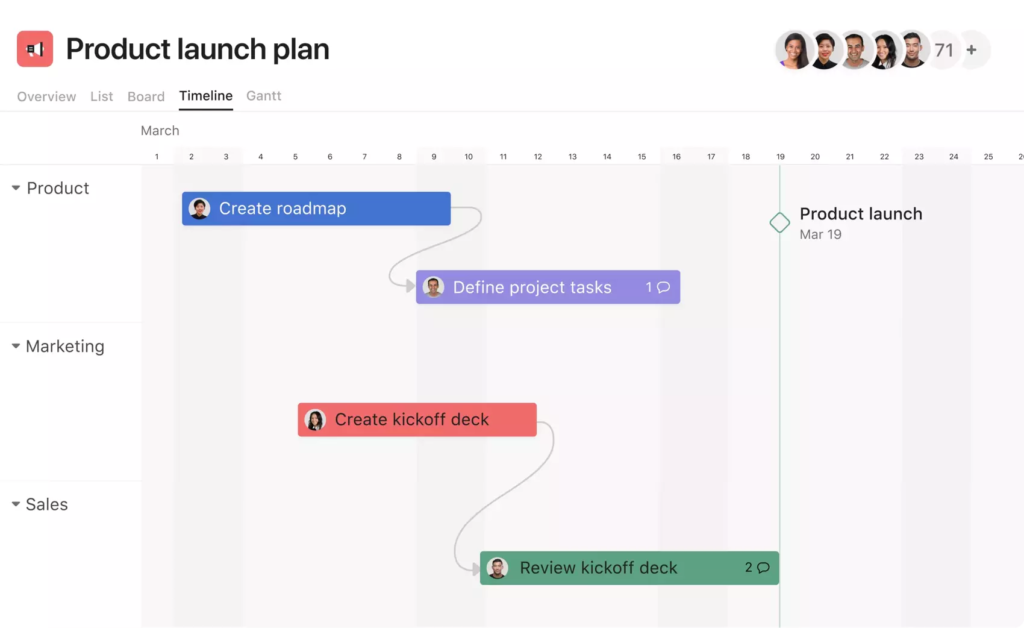What is Asana
Asana stands out as a versatile project management tool, ideal for various team sizes. Its user-friendly interface, coupled with diverse features like task management, project visualization (including Kanban and Gantt charts), and robust team collaboration tools, makes it a top choice. Additionally, Asana’s integration capabilities with other apps enhance workflow efficiency. Offering a range of pricing plans, including a free version for smaller teams, Asana caters to a broad spectrum of organizational needs. It’s particularly recommended for its ease of use, extensive integrations, and comprehensive project management features.

Key Features of Asana
- Task Management: Asana excels in task management, allowing users to create, assign, and track tasks efficiently. This feature ensures that team members are always aware of their responsibilities and deadlines, promoting productivity and accountability.
- Project Visualization: With options like Kanban boards and Gantt charts, Asana offers versatile visualization tools. These features aid in understanding the project flow and milestones, making it easier to manage timelines and resources.
- Team Collaboration: Asana fosters seamless team collaboration. It allows for easy communication within tasks, sharing of files, and updating progress, thus keeping everyone on the same page and enhancing teamwork.
- Integration Capabilities: The platform integrates with a wide range of other applications and tools, streamlining workflows and automating processes. This integration makes it a flexible tool that can adapt to various business ecosystems.
- Customization and Reporting: Asana offers extensive customization options, including custom fields and reporting features. These allow teams to tailor their project management experience and generate insightful reports for better decision-making.
- User-Friendly Interface: The intuitive interface of Asana is designed for ease of use, making it accessible for teams regardless of their technical expertise. This simplicity ensures a smooth onboarding process and enhances overall user experience.
What is Superlist
Superlist is a to-do list app designed for both individual and team use, currently in beta phase. It was developed by some of the creators of the successful Wunderlist app. Superlist offers features like task creation, notes, sub-tasks, list management with full text-formatting, and real-time collaboration. It integrates with popular apps like Microsoft To-Do, Google Calendar, Gmail, Slack, and Linear, among others. The app is available for iOS, Android, Web, and macOS, and offers a fast, user-friendly experience with a focus on productivity and simplicity.
Key Features of Superlist
- Task Creation and Management: Superlist provides a streamlined interface for creating and managing tasks. Users can easily add, modify, and organize tasks, making it a versatile tool for personal and professional task management.
- Note-taking and Sub-tasks: Alongside task management, Superlist allows users to add detailed notes and create sub-tasks. This feature is particularly useful for breaking down complex tasks into manageable parts and keeping all related information in one place.
- Full Text Formatting in Lists: Superlist stands out with its full text formatting capabilities within lists. This feature enhances readability and organization, allowing users to customize the appearance of their tasks and notes for better clarity.
- Real-time Collaboration: The app facilitates real-time collaboration, enabling teams to work together on tasks and projects seamlessly. This feature is vital for coordinating team efforts and ensuring everyone is on the same page.
- Integration with Other Apps: Superlist integrates with several popular applications, such as Microsoft To-Do, Google Calendar, Gmail, Slack, and Linear. This connectivity ensures a smooth workflow and allows users to sync their tasks across different platforms.
- Cross-platform Availability: The app is available across multiple platforms, including iOS, Android, Web, and macOS. This wide availability ensures users can access and manage their tasks from any device, enhancing flexibility and accessibility.
Asana vs Superlist: Features
| Features | Asana | Superlist |
|---|---|---|
| Integrations | Google Drive, Slack, Zoho Cliq, Zapier, Jira, Zoom, Toggl Track, Loom, Harvest, Gmail | Microsoft To Do, Google Calendar, Gmail, Slack, Linear, Apple |
| Calendar | Yes | No |
| Platforms | macOS, iOS, Android, Web, and Windows | Available on macOS, iOS, Android, and Web |
| Task Management | Task creation and assignment, due date setting, progress tracking, project organization, tagging, comments, file attachments, task conversations | Task creation and management, subtasks, collaboration tools, cross-device functionality, and reminders |
| Natural Language Processing | Yes | No |
| Time Blocking | No | No |
| Analytics | Yes | Yes |
| Meeting Scheduler | No | No |
| Time Zones | Yes | No |
| Reminders | Yes | Yes |
| Customer Support | Average | Average |
| 1:1 User Onboarding | Asana offers customer success services including tailored training and consultation, which might include onboarding calls for new users, especially in enterprise plans | No |
| Pricing | Asana offers three plans: the free Personal plan for basic needs, the Starter plan at $11.59 for expanded features like timeline view, and the Advanced plan at $25.69 for comprehensive project management tools including time tracking and advanced customization. | Superlist offers a Free, Pro ($8/month), Free Team, and Pro Team ($10/member/month) plans |
Asana vs Superlist: Pricing
Asana Pricing
Asana offers three main pricing tiers:
(i) Personal: This is a free plan, suitable for small teams or individuals. It includes basic project and task management features and supports collaboration with up to 10 team members. Users have access to unlimited tasks, projects, messages, and file storage.
(ii) Starter: Priced at $11.59 per user per month, this plan builds on the Personal plan. It allows collaboration with up to 500 teammates and introduces additional features like timeline and Gantt chart views, along with the ability to use forms and automation.
(iii) Advanced: At $25.69 per user per month, the Advanced plan includes all features from the lower tiers and adds functionalities such as goals, time tracking, proofing, approvals, and more advanced customization options.
Each tier offers a range of features to accommodate different needs, from individual use to more complex team collaboration and project management requirements.
Superlist Pricing
Superlist offers the following pricing plans:
(i) Free Plan: This plan includes unlimited tasks, notes, reminders, private lists, and up to 5 shared lists with 5 people. It supports Gmail, Google Calendar, email forwarding, and imports from Microsoft To Do, along with email task summarization. The file storage limit is up to 10MB for uploads and 500MB in total.
(ii) Pro Plan: Priced at $8 per month, this plan includes everything in the Free plan, plus unlimited shared lists with up to 25 people, integrations with Slack, Github, Linear, Figma, unlimited AI features, and increased storage (500MB for uploads and 25GB total).
(iii) Free Team Plan: Aimed at smaller teams, this plan is free per member per month and includes everything in the Free plan, along with 15 shared lists between team members and a limit of up to 5 team members.
(iv) Pro Team Plan: At $10 per member per month, this plan includes everything in the Pro plan, with the addition of unlimited shared lists with team members and guests, no limit on the number of team members, and an upgrade for every team member to personal Pro.
Asana vs Superlist: Reviews
Asana Review
Asana, a popular project management tool, is praised for its intuitive interface and robust feature set, making it an excellent choice for teams of all sizes. Key strengths include versatile project views, effective task and assignment management, and smooth team collaboration. Users benefit from a variety of project views like Kanban Board, Timeline, and Gantt, alongside templates for quick project setup. Asana’s progress tracking and integration with various tools like Google Suite and Microsoft 365 further enhance its utility. However, the tool’s complexity might be overwhelming for beginners, and the cost of the Advanced package may be a concern for smaller teams or individual users.
Superlist Review
Superlist is highly appreciated for its ease of use, offering efficient task creation, management, and collaboration features. It integrates well with tools like Google Calendar and Slack, enhancing productivity. Available on multiple platforms, it’s ideal for both individual and team use. However, some users find the note-taking feature within lists a bit cumbersome as important notes can get lost in extensive lists. The task assignment process can also be tedious, especially for solo users who need to assign tasks to themselves repeatedly.
Which One Should You Pick
Consider Asana if
- You’re Managing Diverse Projects: Asana is suitable for various project types, offering flexibility with multiple view options like Kanban and Gantt charts. However, it might take time to master all the features.
- You Value Integration: Asana’s integration with many tools (like Google Suite, Microsoft 365) enhances its utility. But, be mindful that depending on external apps could complicate workflows.
- You Prioritize Team Collaboration: Asana is strong in team collaboration features, making it easy to track responsibilities and updates. Still, for very small teams or individual use, the platform might offer more than needed.
Consider Superlist if
- You Value Simplicity in Task Management: Superlist is a good choice if you prefer a straightforward, user-friendly interface for managing tasks and notes, without too many complex features.
- Collaboration Is Key for You: It’s suitable for teams who need real-time collaboration on projects and tasks, though it might not offer advanced project management features like some competitors.
- You Use Integrations Regularly: Superlist integrates with popular tools like Google Calendar and Slack, making it a practical option if these integrations align with your workflow needs. However, its integration options might be limited compared to more comprehensive tools.
Best Asana and Superlist Alternatives
- Akiflow: Akiflow is a time management app offering time blocking, task scheduling, and integrations with various tools. It focuses on productivity and organization through a unified task and appointment interface.
Akiflow Price: $19 per month, paid annually - Todoist: Todoist is a task management tool. It enables users to manage tasks, set priorities, and track deadlines across various devices. Its features include task categorization, reminders, and project collaboration, making it suitable for both personal and team productivity.
Todoist Price: Premium at $4 per month, paid annually - Trello: Trello is a visual collaboration tool for planning tasks and projects. With an intuitive interface of boards, lists, and cards, it helps teams organize work and manage projects effectively.
Trello Price: Free Plan for individuals and small teams, Standard Plan at $5 per user/month (billed annually), Premium Plan at $10 per user/month (billed annually), and an Enterprise Plan for larger organizations at $17.50 per user/month (billed annually)



